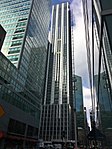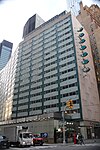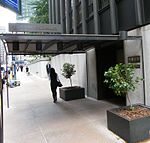DoubleTree by Hilton Hotel Metropolitan New York City (originally the Summit Hotel; formerly the Loews New York Hotel and Metropolitan Hotel) is a hotel in the East Midtown neighborhood of Manhattan in New York City, United States. Designed by architect Morris Lapidus, in association with the firm of Harle & Liebman, the hotel is at 569 Lexington Avenue, at the southeast corner with 51st Street. The DoubleTree Metropolitan Hotel is owned by Hawkins Way Capital and contains 800 rooms. The hotel building, designed in the Miami Modern style, is a New York City designated landmark.
The hotel is 20 stories tall and stretches from west to east, with an "S"-shaped massing bent at two places. The hotel has a facade made of marble, turquoise glazed brick, and dark-green tile. There are storefronts along both 51st Street and Lexington Avenue. Above the DoubleTree's main entrance on Lexington Avenue is a vertical sign, consisting of ovals that originally spelled out the hotel's name. The lowest stories contained the lobby, three Latin American-themed dining areas, various shops, and meeting rooms. When the Summit Hotel opened, it contained 800 guest rooms, including 200 rooms with balconies on the upper stories.
The site was previously occupied by the Loew's Lexington Theatre, which was built in the 1910s. Loew's Theatres announced plans to replace the theater in early 1960, and a groundbreaking ceremony for the hotel took place on June 21, 1960. The Summit Hotel opened on August 1, 1961, and was Manhattan's first new hotel for short-term tenants in thirty years. When the Summit opened, its facade and interior were almost universally criticized, though the building's shape had a mixed reception. Over the years, the hotel has been renovated several times. The Summit was renamed the Loews New York Hotel in 1991 and became the Metropolitan Hotel in 2000. Loew's sold the hotel in 2003 to a joint venture, which rebranded it as part of the DoubleTree chain in 2005. The hotel was sold to RLJ Lodging Trust in 2011, and it was resold yet again in 2022 to Hawkins Way Capital. As of 2022, the hotel was closed indefinitely due to the COVID-19 pandemic in New York City.








